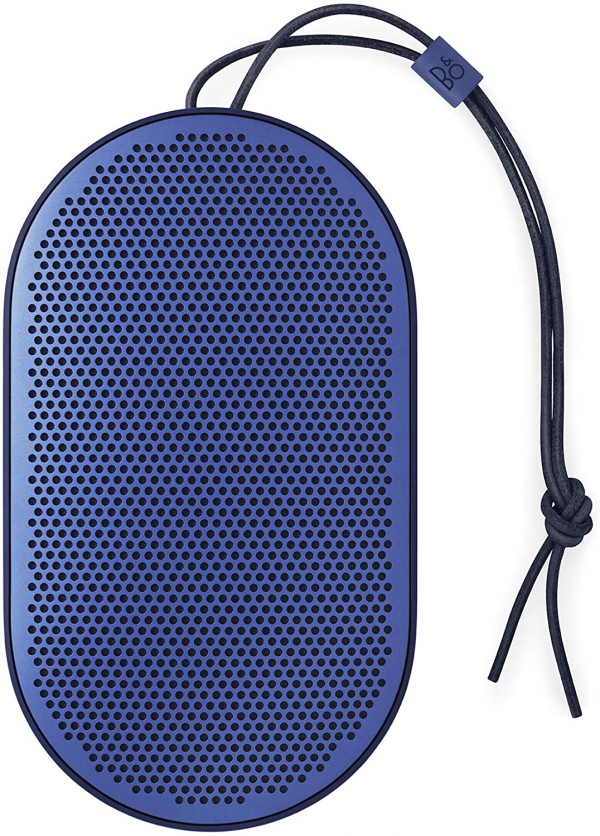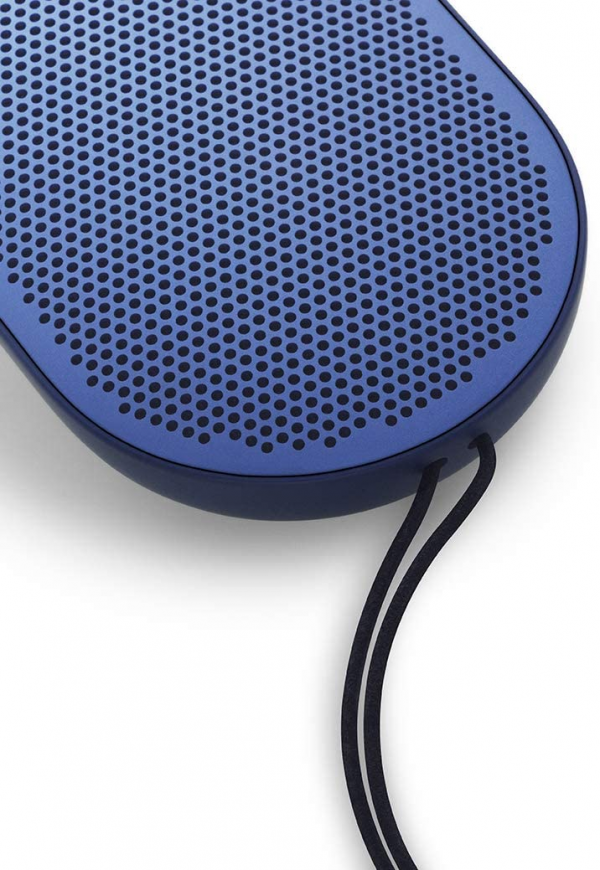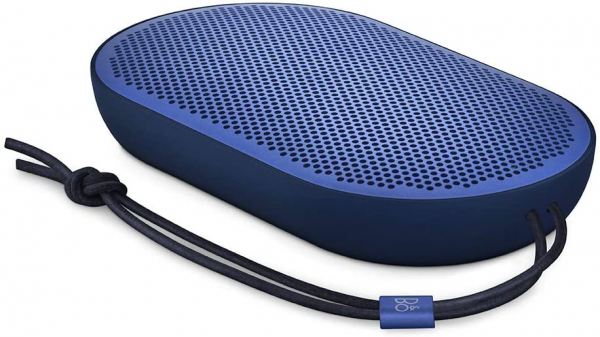B&O Play
B&O Play Beoplay P2: the frog that wants to be as big as the beef
Aprox. 169€ - see price -
See specificationsThe P2 is the first ultra-portable speaker from B&O Play. Designed as a "personal" Bluetooth speaker to take everywhere with you, it also stands out for its somewhat special ergonomics, which almost completely dispenses with physical buttons. A good idea, do you think ...
Positive points
Successful design.
Rather clean midrange and treble.
Simultaneous connection to two sources possible.
USB-C charging port.
Possibility of connection as an external audio device on PC.
Bad points
Low end of the spectrum very confused.
Treble too far back.
Almost no command available on the speaker.
No analog input.
Disappointing hands-free kit microphone.
Our review
Ergonomics
No aesthetic revolution at B&O Play: the look of the P2 is still signed by the Danish designer Cecilie Manz, to whom we already owe the appearance of all the other other portable speakers. So here we find the association of curved shapes and matt textures which already made up the body of the Beoplay A1, for example. This design is rather elegant and successful, but we unfortunately regret not entirely flawless finishes: the rubbery plastic covering the perimeter of the speaker shows a certain tendency to catch fingerprints, while the very thin anodizing layer of the aluminum grid can be chipped a little too easily. It's a shame, especially for an enclosure that is otherwise resistant to splashes and dust.
Compatible with Bluetooth 4.2, the P2 seems at first glance to be completely devoid of wired audio connections ... which is not completely true, since its USB-C port can be used not only for recharging the speaker, but also to connect it to a PC as an external audio device. This last mode of use works in plug & play for both Windows and MacOS, without the need to manually install a driver. A very good point, which however does not completely forget the absence of analog input.
Let's go back to Bluetooth. It is possible to connect two sources simultaneously to P2, one or the other of these being capable of exchanging priority on the stream broadcast according to the use made of it. The speaker has a microphone allowing the use in hands-free kit, but this unfortunately offers a rather mediocre voice; the capture has certainly the merit to be done at 360 °, but it is accompanied by an overly aggressive noise reduction which strongly distorts the vocal timbres and which can also singularly harm the intelligibility of speech.
It is time to discuss the speaker controls, and this is where the P2 collapses completely. In the name of preserving the purity of its design, B&O Play has seen fit to place almost no physical button on the enclosure; only one button remains on the underside to control the on / off of the speaker and the activation of the Bluetooth pairing. Apart from that, the user-speaker interface boils down to only two possible inputs: double tapping on the grid or shaking the speaker. By default, the first is used to pause / play music, the second is used to skip to the next track. What about everything else? It will be necessary to perform operations on the source device.
No, you are not dreaming, it does mean that it is especially impossible to adjust the volume directly on the speaker. And how do we do when we want to connect the P2 to a source that is not compatible with remote volume control in Bluetooth? There is a solution: you must connect the speaker simultaneously to the source and to your smartphone (iOS or Android), on which you will have taken care to install the Beoplay application. It is then possible to use the latter as a "remote control" for the speaker. All this to royally gain the right to adjust the sound volume as desired. Why keep it simple ...
Since we talked about the mobile application, note also that it allows you to assign other functions to the shaking or tapping of the enclosure. We can, for example, ask the tapping to call the voice assistant of his smartphone or even the shaking to activate / deactivate the Tonetouch sound processing - we will come back to this in the audio section. It is finally possible via this app to configure the P2 as an alarm: tapping then acts as a snooze button, while shaking completely turns off the alarm.
The autonomy, announced by the manufacturer at 10 o'clock, actually amounts to only 5:30 (volume set to half of its maximum value). This breach of the promise is obviously irritating, but the value remains intrinsically suitable for an enclosure of this size. With its thickness and weight less than 3 cm and 300 grams respectively, the P2 can slip without too much trouble into a large pocket of jeans - which earned it, according to our nomenclature, the title of ultra-portable speaker.

Audio
In terms of sound performance, the P2 has a number of points in common with its big sister, the A1. Do not see this as good news: the two brothers have in common that they are too ambitious for their own good, both in terms of power and extension in the bass.
Armed with its 30 W amplification, the P2 can effectively reach a sound volume quite surprising for its size. The counterpart of this ardor is on the other hand less surprising: a sound which singularly lacks control and definition, especially in the lower part of the spectrum. Everything below 400 Hz is very muddled, the fault first of all with a very marked coloring, then with a clearly perceptible distortion.
Things work out from the midrange, but another problem manifests at the other end of the spectrum: treble extremes too clearly set back, resulting in a noticeably blunt tone. The intensity of this problem, however, depends on the vertical angle from which you place yourself in relation to the speaker, since the latter radiates upwards, and its treble is of course much more directive than the mid and low range. But even by positioning itself at the zenith of the enclosure, it remains present and audible.
Concretely, the rendering of P2 is therefore particularly unflattering for rich music across the spectrum, which takes on a puffy, confused and singularly unnatural tone. So there is no point in hoping to enjoy songs with a slightly dense mix; and we're not even talking about orchestral music. The speaker comes out with more happiness on light acoustic music or even simply for listening to podcasts, since the human voice is clearly one of the sounds it reproduces with the most ease.
Let us quickly mention the Tonetouch effects available via the Beoplay mobile application; none offers an interesting change in the sound of the speaker. They only add a color that further degrades the rendering.
Special mention to the functionality supposed to make the soundstage more spacious, and which in reality accomplishes exactly the opposite: by further accentuating the hollow of the frequency response in the low mids, it produces a very arid and skimpy sound.
A final word on Bluetooth latency, which is around 220 ms. It's too much to be able to comfortably watch a video. As far as possible, it will therefore be necessary to take the trouble to compensate for this difference via the reading software.

Conclusion
After Beoplay A1, the overflow of ambition from B&O Play regarding the capacities of its portable speakers seems to be confirmed. This P2 clearly had the potential to offer a clean, natural and richly honorable rendition for its small size; but trying too hard to go down in the bass and gain power, it ends up suffocating its own qualities. Added to this is "innovative" ergonomics with gaping gaps which removes P2 any chance of teasing the champions of our comparison of ultra-portable. Too bad, because it is one of the most expensive speakers there ...

Specifications
Reviews


Sounds great, less filling
I bought the Beoplay P2 and the UE Wonderboom. Both claim 10 hours of play, so they are comparable in stature.
My first point is about the sound. The P2 is vastly superior to the Wonderboom. It's not even close. If this is your concern, get the P2. If this is not your concern, just grab eight D size batteries and prop up your boom box on your shoulder and walk down the street with your best Nirvana cassette tape blaring.
Next: the size. The P2 is much smaller. It's about an inch longer than the Wonderboom is tall, but magnificently thinner. You could stick this in your pocket if you are a guy. Girls, you can stick it in your guy's pocket. If the Wonderboom can fit in your pocket, you might want to trade in your cargo pants for something newer.
Third: ruggedness. Well, this is no contest, obviously. The P2 is a stuck up little piece of equipment and can only withstand some petty splashes. Go ahead and throw your Wonderboom in the lake, see if it cares. It does not.
I am keeping both since the Wonderboom is a trooper in all the elements. But the P2 really sounds way better. It's as if Tay Tay is singing directly into my ear. But I am glad the Wonderboom can survive a day on the inflatable pool swan.
Absolutely great sound, B&O never fail to impress me with ...
Absolutely great sound, B&O never fail to impress me with their signature sound.
** Update **
Had to take 2 star off because after about a week getting it I feel like the battery life is worse than I thought. The battery goes 50% @ 30% -40% volume in about 1-2 hours. The speaker also have some kind of distortion when connected with USB-Type C for some reason but not bluetooth.
Quality Control Problem? Change that to poor product roll-out.
This amends a post from yesterday - triggered by some customer replies to my post. Soundwise, this product is amazing for its size. I also have the B&O A1 and A2, with the A2 providing better heft for outside playing, and the A1 perhaps sounding even better than the A2 in smaller interior rooms. The P2 sounds very similar to the A1. VERY rich and detailed sound for a speaker this size .... amazingly so. Your choice between the two is likely decided based on your priorities: P2 is indeed lightweight and compact; the A1, while substantially heavier (and larger), is much easier to control as it does have an array of "buttons" that can be manipulated (provided one has the good eyesight to see them).
There are still some downsides ... Yes, I did have to return the first one ordered and received because it simply did not work at all. Most of my complaints, however, reflect product roll-out screw-ups rather than the product, itself. First mistake: a minimalist product ALWAYS requires a maximalist user's guide if one is to figure out the device's array of non-intuitive features. The download-able manual is only a slight improvement over the nearly worthless pamphlet (mostly warranty stuff) that comes in the box.At the very least, the enclosed manual should have directed the buyer to IMMEDIATELY check for a firmware update, furnished the link , and instructed to ignore the fact that the updater appears to not apply to the P2. Thanks to a thoughtful respondent to my post, I did proceed onward with a firmware update and it corrected the problem with the unit not shutting off when the on / off button is pressed ..
Another problem resides in the fact that the Beoplay app - a big target for complaints already - has not been improved through its latest update to effectively deal with the P2. Neither a Samsung tablet nor a Motorola cellphone have been able to link up to the P2 more than for a few minutes in 2 days of use ... and only after 15 minutes or so of trying. My cellphone is still trying after about an hour. This is a big problem, as the only way possible to switch between primary functions - playing music, handling calls, setting an alarm - can only be done through this app.
Finally, it would have been nice to be able to adjust the volume through some manipulation of the P2, itself. I did read a review online that said this was possible by tracing a circle on the top of the unit (like turning a volume nob), but this seems to be a fantasy wish.
In conclusion, this is a great sounding and great looking sound accessory, worthy of your purchase right now if you really just want to play music. If B&O makes big improvements to its app and devotes more effort to explaining how to use their stuff versus wowing potential customers with overproduced webpage marketing videos, eventually you will be able to realize the P2's full potential.
Oustanding sound quality overrides any negatives
The sound quality is so great on this that it overrides any flaws. I've heard most of the popular bluetooth speakers and I've always been underwhelmed by the sound. I have a Bose Soundlink Mini that I was looking to replace because I found I only wanted to listen to podcasts on it; For music it produced impressive bass and volume but the bass was boomy and muddy, combined with a lack of treble detail it just sounded compressed and murky. This has a tight, punchy, well-controlled bass that doesn't bleed into the midrange and muck everything up combined with a sparkling treble that just sounds amazing. To be clear, this is not 'room filling' sound in the same way that the Bose could sound like a bookshelf-sized speaker, although it's not bad either. But this thing can fit in your pocket and be easily tucked into a backpack or purse without weighing you down.
Negatives: No line in, this is a bluetooth-only device. If you want to connect a non-bluetooth device to it you should pick up a bluetooth transmitter. Battery life - it lasts about 6-8 hours on a charge. But it fits in the palm of your hand! I usually listen while working so I just charge it off my laptop. Lack of controls - there is no volume control on the device. You can skip tracks forward by shaking it which is ridiculous. You cannot skip back to the beginning or to the previous track. You can pause by double tapping the speaker grill which is OK, but it needs to be sitting on a hard surface for it to work.
One other thing - I thought the leather strap was going to be useless, but it's actually pretty handy. You can hang it from a doorknob, or if you were camping you could hang it from a tree branch or something.
sound quality is great if you don't like bass
sound quality is great if you don't like bass. I returned this and bought two bose sound link mini's. now the bose does not go as loud, how ever I was willing to give up volume due to the better depth in sound from the bose.